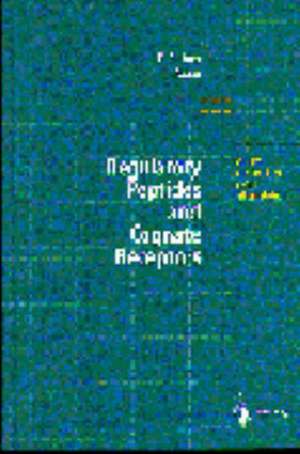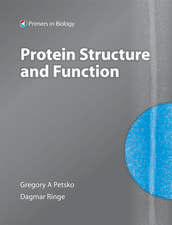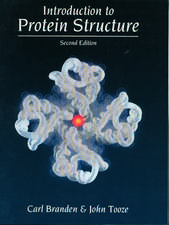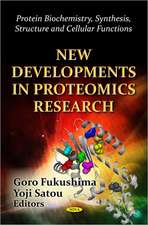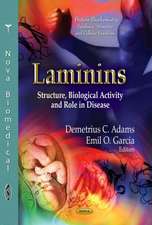Regulatory Peptides and Cognate Receptors: Results and Problems in Cell Differentiation, cartea 26
Editat de Dietmar Richteren Limba Engleză Hardback – 18 iun 1999
| Toate formatele și edițiile | Preț | Express |
|---|---|---|
| Paperback (1) | 1220.88 lei 6-8 săpt. | |
| Springer Berlin, Heidelberg – 3 oct 2013 | 1220.88 lei 6-8 săpt. | |
| Hardback (1) | 1227.04 lei 6-8 săpt. | |
| Springer Berlin, Heidelberg – 18 iun 1999 | 1227.04 lei 6-8 săpt. |
Din seria Results and Problems in Cell Differentiation
- 18%
 Preț: 1391.73 lei
Preț: 1391.73 lei - 15%
 Preț: 597.16 lei
Preț: 597.16 lei -
 Preț: 387.96 lei
Preț: 387.96 lei - 5%
 Preț: 373.33 lei
Preț: 373.33 lei -
 Preț: 382.18 lei
Preț: 382.18 lei -
 Preț: 385.08 lei
Preț: 385.08 lei - 15%
 Preț: 644.82 lei
Preț: 644.82 lei - 15%
 Preț: 634.00 lei
Preț: 634.00 lei -
 Preț: 387.20 lei
Preț: 387.20 lei -
 Preț: 387.75 lei
Preț: 387.75 lei - 15%
 Preț: 643.34 lei
Preț: 643.34 lei -
 Preț: 382.18 lei
Preț: 382.18 lei -
 Preț: 394.71 lei
Preț: 394.71 lei -
 Preț: 390.08 lei
Preț: 390.08 lei -
 Preț: 381.43 lei
Preț: 381.43 lei -
 Preț: 385.47 lei
Preț: 385.47 lei -
 Preț: 385.47 lei
Preț: 385.47 lei -
 Preț: 391.22 lei
Preț: 391.22 lei - 20%
 Preț: 561.68 lei
Preț: 561.68 lei - 5%
 Preț: 1418.27 lei
Preț: 1418.27 lei -
 Preț: 386.00 lei
Preț: 386.00 lei -
 Preț: 377.95 lei
Preț: 377.95 lei -
 Preț: 391.61 lei
Preț: 391.61 lei -
 Preț: 388.52 lei
Preț: 388.52 lei - 18%
 Preț: 1380.63 lei
Preț: 1380.63 lei - 15%
 Preț: 639.25 lei
Preț: 639.25 lei - 18%
 Preț: 1220.12 lei
Preț: 1220.12 lei - 15%
 Preț: 642.51 lei
Preț: 642.51 lei - 15%
 Preț: 640.37 lei
Preț: 640.37 lei - 18%
 Preț: 1222.49 lei
Preț: 1222.49 lei - 18%
 Preț: 946.41 lei
Preț: 946.41 lei -
 Preț: 387.38 lei
Preț: 387.38 lei - 18%
 Preț: 1228.47 lei
Preț: 1228.47 lei - 15%
 Preț: 642.51 lei
Preț: 642.51 lei - 18%
 Preț: 1663.00 lei
Preț: 1663.00 lei - 18%
 Preț: 1225.62 lei
Preț: 1225.62 lei
Preț: 1227.04 lei
Preț vechi: 1496.40 lei
-18% Nou
Puncte Express: 1841
Preț estimativ în valută:
234.82€ • 254.98$ • 197.25£
234.82€ • 254.98$ • 197.25£
Carte tipărită la comandă
Livrare economică 22 aprilie-06 mai
Preluare comenzi: 021 569.72.76
Specificații
ISBN-13: 9783540653257
ISBN-10: 3540653252
Pagini: 384
Ilustrații: XIII, 366 p. 22 illus.
Dimensiuni: 155 x 235 x 29 mm
Greutate: 0.71 kg
Ediția:1999
Editura: Springer Berlin, Heidelberg
Colecția Springer
Seria Results and Problems in Cell Differentiation
Locul publicării:Berlin, Heidelberg, Germany
ISBN-10: 3540653252
Pagini: 384
Ilustrații: XIII, 366 p. 22 illus.
Dimensiuni: 155 x 235 x 29 mm
Greutate: 0.71 kg
Ediția:1999
Editura: Springer Berlin, Heidelberg
Colecția Springer
Seria Results and Problems in Cell Differentiation
Locul publicării:Berlin, Heidelberg, Germany
Public țintă
ResearchCuprins
The ‘Chicken and Egg’ Problem of Co-evolution of Peptides and Their Cognate Receptors: Which Came First?.- Thyrotropin Releasing Hormone (TRH), the TRH-Receptor and the TRH-Degrading Ectoenzyme; Three Elements of a Peptidergic Signalling System.- Corticotropin-Releasing Factor (CRF) and its Role in the Central Nervous System.- CRF and CRF Receptors.- Neural Oxytocinergic Systems as Genomic Targets for Hormones and as Modulators of Hormone-Dependent Behaviors.- Vasopressin Receptors: Structural Functional Relationships and Role in Neural and Endocrine Regulation.- The Oxytocin Receptor.- Targeted Mutagenesis of the Murine Opioid System.- Orphan Receptors and the Concept of Reverse Physiology: Discovery of the Novel Neuropeptide Orphanin FQ/Nociceptin.- Molecular Biology of the Receptors for Somatostatin and Cortistatin.- Novel Neurotransmitters for Sleep and Energy Homeostasis.- Galanin and Galanin Receptors.- The Cholecystokinin — Gastrin Family of Peptides and Their Receptors.- Function of the Neuropeptide Head Activator for Early Neural and Neuroendocrine Development.- Invertebrate Neurohormones and Their Receptors.
Textul de pe ultima copertă
In the last two decades, our knowledge on regulatory peptides and their cognate receptors, most of which are members of the seven transmembrane receptor families, has increased enormously. Regulatory peptides are small proteins which, besides their hormonal functions in regulating cellular metabolism in various tissues, may also act as neurotransmitters, and thus they often carry the prefix "neuro". Many of the cognate receptors involved in transducing the peptidergic signal across the cell membrane via a familiy of G proteins exist in multiple forms, the number of which frequently exceeds that of the corresponding peptide ligands. In this book, various peptide-receptor systems are discussed, e.g CRF, somatostatin, TRH, opioid peptides, vasopressin, and oxytocin. It also discusses new strategies such as "reverse physiology" to uncover new peptides and orphan receptors.
Caracteristici
This book summarizes the latest advances in the important and fast-moving field of regulatory peptides and receptors Includes supplementary material: sn.pub/extras
